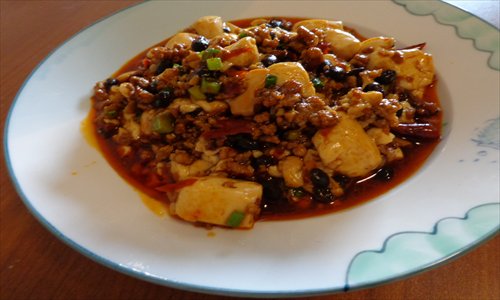
Mapo doufu Photo: Julie Bertoni/GT
The Western world does not know tofu. Not really. Not in any meaningful sense. We relegate this versatile source of protein to the tables of vegetarians and vegans, and our cuisines have made no room for the ingredient in any mainstream dish, save for a note at the bottom of a recipe saying that tofu can be used in place of something or other. Worse yet, it's slated as a health food, conjuring up an attitude that turns the experience of dining into a checklist of nutrients, sucking all the fun out of the dinner table.
In China, tofu, or doufu, is not an ingredient, it's a universe.
I regret that my two years as a vegetarian came long before I arrived in China. Now, a sworn meat eater, I am finally exposed to the full breadth of the magic drawn from bean curd. Coming from a country where the average Joe turns his nose up at a tofu option on a menu, I was delighted to see families order doufu dishes alongside pork and duck, and eat them with equal gusto.
In Chinese cuisine, cooking with tofu is a fine art, its medium more malleable than clay, its masterpieces more varied than sculpture the world over. To know tofu is to admire it, to revere it, and to celebrate it.
Its life begins in the soybean, which is soaked, ground, boiled and strained to extract a nutritive, milky substance that can be wielded in an astounding number of ways. Tofu masters pull away the skin that settles on top of the warm, thick milk, and the liquid that remains is then pressed, smoked, fermented, frozen, and dried.
It comes in soft, droopy cubes that slip into halves when grasped too hard with chopsticks; it is textured, pressed squares wrapped around succulent strips of pork; it is an oily, dried band that gets dropped into a roiling vat of hot pot broth; it is cold, soft, chewy strips dressed in sesame oil and chilis, heaped in a pile with sundry vegetables and aromatic leaves. In a word, it is heaven.
Over the last year and a half here in Beijing, I have thought more about this food than any other, and that's saying a lot. But as tofu masters are fluent in the vast world of bean curd, I knew that before I could create my own homemade tofu, I first had to learn what is done with its incarnations. I chose two common dishes to facilitate my elementary education, my exploration of tofu, for beginners.
Mapo doufu
The origin story for this dish is one of those tales of "she only had these ingredients to work with, and poof!" - a trope whose ubiquity should fire up the confidence of any home cook. While this spicy concoction is often translated as "home-style tofu," it literally means something closer to "pockmarked crone tofu." Legend goes that an elderly woman living on the edge of Chengdu, Sichuan Province, would cook for traveling workers who offered ingredients, here ground meat and tofu. Over time, her recipe became known far and wide - proof of her cooking skills as well as the fact that meat and tofu needn't live in separate camps.
One thing I have learned from this recipe is that ingredients certainly make the dish. The tofu must be dangerously soft, the preserved black beans (豆豉) flavored according to tradition, and the pixian sauce(郫县辣酱), a brilliant red, piquant condiment, must accept no substitutes. Having said that, home chefs should feel free to toy with the heat in this recipe, which is written for a medium-high spice tolerance.
Ingredients:
-400 grams soft tofu
-700 milliliters water
-pinch salt
-45 milliliters peanut or other high-heat oil
-200 grams ground pork
-5 dried chilis, cut into 1-centimeter sections, seeds removed

Copyright ©1999-2011 Chinanews.com. All rights reserved.
Reproduction in whole or in part without permission is prohibited.